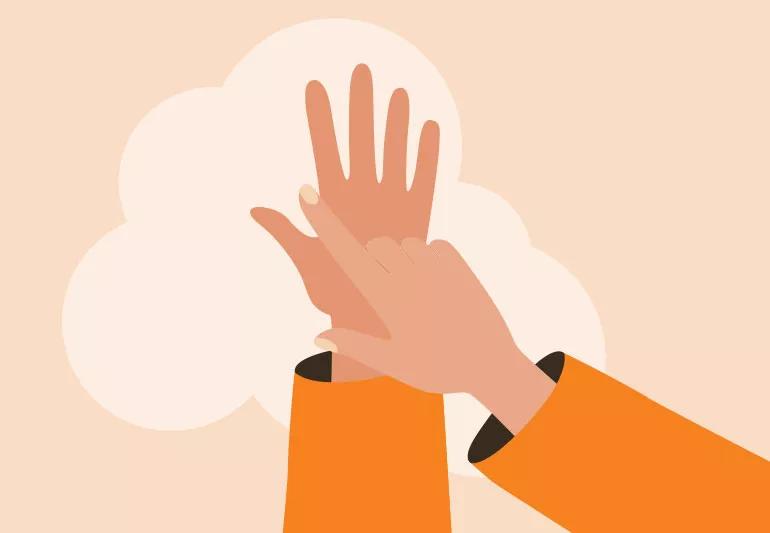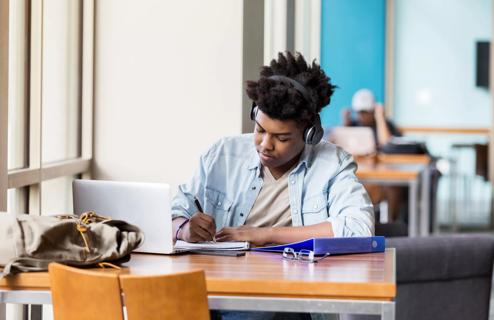This multisensory breathing technique can bring you peace, calm and even pain relief

In a go-go-go world, it’s all too easy to get stuck in fight-or-flight mode, even when you’re not facing any true threats. But if you make a conscious effort to step back, slow down and let your brain work its magic, you can find the kind of peace and calm that can change your entire state of being.
Advertisement
Cleveland Clinic is a non-profit academic medical center. Advertising on our site helps support our mission. We do not endorse non-Cleveland Clinic products or services. Policy
Five-finger breathing is a deep relaxation and breathing that can help you do just that.
Pain specialist and behavioral medicine psychologist Judith Scheman, PhD, explains what this is, how to do it and how it can help you relax, unwind and even manage pain.
Five-finger breathing is a simple but powerful breathing technique that induces deep relaxation — and you can do just about anywhere (though, not while driving or operating other heavy machinery, please).
Unlike other types of breathwork, five-finger breathing is a multisensory experience where you concentrate on more than just your breath. You also focus on the movement and sensation of one hand touching another, slowly and with intentionality.
This helps your brain enter a state of deep relaxation, which causes it to release endorphins. “Endorphins are the body’s natural painkillers,” Dr. Scheman explains. “They’re chemically identical to opioids, but they don’t cause constipation, or sometimes itching, nausea or vomiting, and they don’t disrupt your sleep or your immune system.”
In other words, you can think of endorphins as your body’s safe, all-natural drug — and deep relaxation is the factory where that drug is made.
Breathwork techniques trigger your parasympathetic nervous system, the part of your brain responsible for resting, relaxing and resetting. When you’re tense, overwhelmed or amped up, these techniques help move you out of fight-or-flight mode and into a calmer state of being.
Advertisement
And although anyone can benefit from five-finger breathing, it’s especially beneficial to people who are headed into surgery or who are recovering from a recent procedure.
“You might do this relaxation technique with your eyes closed as soon as they start to take you back to the operating room,” Dr. Scheman suggests. “This will allow you to go into surgery very deeply relaxed.”
Deep relaxation techniques like five-finger breathing have been shown to:
If you’re new to this practice, you may wish to begin by using guided audio or video. Once you’ve gotten the hang of it, you can do it on your own any time you need to relax.
Dr. Scheman walks us through the steps of five-finger breathing.
Five-finger breathing requires the use of two hands. One hand will be your base (this hand won’t move) and the other will be used to trace your fingers (this one will move). It doesn’t matter which is which, but you may find it easiest to use your dominant hand — the one you write with — for tracing.
To start, hold your base hand in front of you with your fingers spread comfortably apart.
Place the index finger of your tracing hand at the bottom of the thumb of your base hand — right where your thumb meets your wrist — and begin slowly moving your index finger up to the tip of your thumb.
“As you move your finger up your thumb, take a slow breath in, perhaps allowing your eyes to close,” Dr. Scheman instructs.
When you reach the top of your thumb, do the opposite: Slowly drag your index finger down the other side of your thumb while exhaling.
When you’re done tracing your thumb, move on to tracing your index finger in the same way — then your middle finger, ring finger and pinky finger.
Advertisement
As you trace each one, continue to breathe deeply and slowly. “Let yourself relax as you breathe gently,” Dr. Scheman encourages. “Become more and more deeply relaxed each time you exhale.”
When you’ve traced your whole hand and reached the bottom of your pinky finger, reverse directions and go back the way you came, moving toward your thumb.
Continue to take slow breaths in and out, focusing on your breath and on the sensation of your index finger tracing your skin. “Let go a little bit more with every exhale,” she says.
Allow yourself to relax as much as you possibly can, with your breath as your guide.
Continue the practice as long as you need. “When you’re ready, you may open your eyes, bringing with you any relaxation that you’ve found,” Dr. Scheman says.
Try not to rush into whatever you do next (unless it involves falling asleep). Give yourself the time to revel in your relaxation and let it wash over you.
It can be hard to get kids to sit still, much less meditate or learn typical breathwork techniques. But five-finger breathing is a simple activity that kids can comprehend, making it a helpful tool for teaching them to calm down and regulate their emotions.
In short, the five-finger breathing technique is for anyone who wants to step back from the frenzy and fervor that life can sometimes bring.
Advertisement
“Add this practice into your schedule, and at end of the day, you can look back and think of it as something you did to take care of yourself,” Dr. Scheman says.
To hear more on this topic, listen to the Health Essentials Podcast episode, “Breathwork for Beginners.” New episodes of the Health Essentials Podcast publish every Wednesday.
Advertisement
Learn more about our editorial process.
Advertisement

Breathing, exercise, mindfulness and more can help you unwind and step away from your stress

From breath meditation to yoga nidra, all types of meditation aim to help you feel calmer, more relaxed and present

Different types of yoga poses, meditation and breathwork may help you feel more emotionally balanced

Sensory deprivation therapy can help relieve stress, improve sleep and decrease physical pain

You don’t need to have years of experience to reap the rewards of meditation — with benefits for your whole body, you only need a couple minutes to get started

While walking, be mindful of your body, your mind, your place in the world and all five of your senses as you pave a path forward, one step at a time

Thunder, waterfalls and heavy rain — these low-frequency sounds might help cancel out disruptive noises and thoughts

Immersing yourself in nature can improve both your mental and physical health

Babies can get congested easily, but you can calm their cough by keeping them hydrated, using nasal drops and running a humidifier

Weight loss may cause loose, sagging skin and muscle loss to your rear

Several conditions, like vitiligo and fungal infection, can cause a loss of pigmentation, leading to white spots or patches on your skin